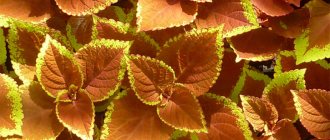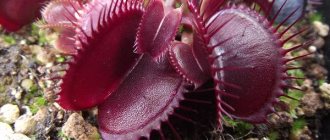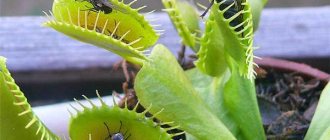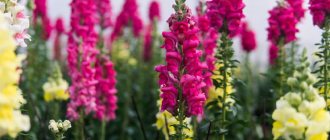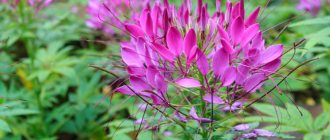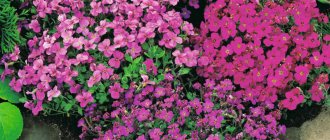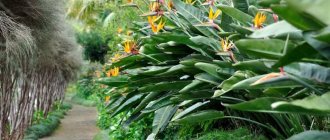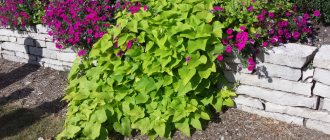The herbaceous perennial plant peppermint (Mentha piperita), or English mint, or chilli, or cold mint, or peppermint, is a species of the genus Mint, belonging to the family Lamiaceae (Lamiaceae). This species was obtained through the hybridization of watermint and spearmint (garden). This plant was considered very valuable back in the days of Ancient Rome; furniture was rubbed with its leaves, and mint infusion was used to spray rooms. In ancient Egypt, mint was placed in the tomb of the pharaohs. This culture was named after the nymph Menta, transformed into a bush with a pleasant, delicate, but very cold aroma. Mint is very popular in English cuisine, where it is used as a spice for lamb sauce. In America, this plant is used as an ingredient in vegetable or fruit salads, and also as an additive to mixed drinks and tomato juice. Peppermint is also used to make medicines with various effects.
Plant varieties
There are a lot of mint varieties for planting in the country. The easiest way to purchase planting material is in garden stores. One of the common varieties of the plant is peppermint. It was developed in the 16th century in England. The stems reach a height of 1.4 m. The plant is lush, with long branches. The leaves are light emerald green, jagged along the edges. Peppermint begins to bloom in July and ends in September. The leaves are used to make teas and fish dishes.
Another variety is curly mint. It received this name because of its curl-like leaves. Plant height is from 30 cm to 1 m. The aroma of the variety is not as strong as that of pepper.
The chocolate mint variety has an unusual smell - a mixture of menthol and lemon with a hint of chocolate. The leaves are dark green with a purple tint.
Mexican mint has a spicy aroma. Plant height up to 1.5 m. Used as a medicinal plant.
Agricultural technology
Mint growing in the country requires almost no care. Newly planted bushes are watered frequently. It is better to do this in the evening hours. Mature plants are moistened less frequently. In rainy summers, mint will have enough natural precipitation; in dry weather, it is watered once every 1.5-2 weeks. Plantings need to be weeded and loosened regularly. Mint roots are located almost at the surface of the soil, so weeds greatly interfere with them. It is more convenient to carry out such care after watering or rain, while the soil is still wet. Moist soil makes it easier to remove weeds without damaging the mint roots.
The culture responds well to fertilizing. It is better to take preparations with a high content of nitrogen and phosphorus for them, but you can also get by with organic compounds - rotted manure or compost. Care in the form of fertilizing is especially important for mint during the period of active growth of its bushes - in the spring. Subsequently, the beds are mulched from time to time, adding wood ash to the compost. In the fall, professionals recommend digging the soil deeply, adding half-rotted manure (2 kg per 1 m²).
Advice
Plantings need to be monitored to prevent them from thickening. Because of it, mint can be affected by powdery mildew.
If you want to get bushy plants, they are periodically trimmed, shortening the top. Then the mint stops stretching upward and begins to actively form side shoots. As a result, more fragrant leaves can be collected from it. If mint bushes grow very tall, you should pay more attention to watering. Usually the plant reacts this way to lack of moisture.
Why is mint dangerous in the garden?
Growing mint on the plot is fraught with some dangers. First of all, this is the active growth of the rhizome. If you do not control mint bushes, then after a while the plant can fill the entire area. The problem will have to be solved radically, that is, some of the plants will have to be dug up and thrown away. Therefore, every year you need to remove some of the bushes if they begin to grow too much.
Differences from lemon balm
Unlike peppermint, lemon balm has a branched stem and flowers, collected not in inflorescences, but in false rings. The aroma is more reminiscent of lemon than menthol. Melissa is inferior in the content of essential oils. Cooks are more often used as a flavoring seasoning, while pepper has earned popularity due to its aromatic properties.
Find out more about the distinctive characteristics of the two plants here.
What conditions does mint need for successful growth?
It is preferable to plant mint in open sunny areas with high humidity. It is not advisable to plant valuable plants next to the bushes, since the powerful root system of mint will not allow them to develop normally. The soil must be fertile and loose. Preference should be given to sandy or loamy soil. It is not advisable to plant plants in wetlands.
Mint planting dates
The optimal time for planting seeds is considered to be early spring. Then the bushes will not die in winter. Planting in the summer will lead to the fact that the plants will not have time to take root in the new place and will die in severe frosts.
It is not advisable to plant mint in the fall; the cuttings will not have time to take root before the onset of winter. This especially applies to the northern regions. It is advisable to finish planting the crop in the first half of August.
See also
Description of the chocolate mint variety, features of growing and caring for the plantRead
Dividing the mother bush
With this method of propagation, new plants retain all the varietal characteristics of the mother plant. You can divide bushes from 3 years and older.
This should be done in late April-early May, provided that there are no sub-zero air temperatures at night.
Dig up the original bush and divide it into several parts. For them to take root, each part must have buds, several shoots and a rhizome.
Plant the separated bushes in holes about 10 centimeters deep, in loose, fertile soil. Sprinkle with soil, compact, water. Further care is the same as for an adult plant.
In order for the cuttings and parts of the mother bush to grow well, after 14-20 days you can fertilize them with a weak solution of urea, one liter per plant.
How to choose quality planting material
Further productivity depends on the quality of planting material. The stage of selecting cuttings and seeds should be given as much attention as possible.
Selecting seeds for planting
It is preferable to buy seeds for planting mint in garden stores. Collecting seeds from the mother plant is a painstaking and thankless task. It will not be possible to grow quality plants from such material. Most of the seeds will not sprout. And the one that sprouts will have characteristics far from the mother plant.
How to choose mint seedlings
The most effective way to plant a plant is from seedlings. Mint seedlings can be purchased at the store or you can dig up part of the mother plant. In both cases, the bushes will take root. You can also grow mint if you cut off the stem from the mother plant at a height of 1 cm from the rhizome. The stem must be placed in water. In a few days it will produce white roots. After this, the cuttings are planted in the soil.
When choosing crop seedlings, you need to pay attention to its appearance. There should be no wrinkled, withered or diseased leaves. The stem is hard and elastic. Such seedlings are suitable for further cultivation. The height of the sprouts should not exceed 6-8 cm. If they are too long, it will be difficult for the seedlings to take root. Purchased seedlings are planted in the soil along with the soil from which the sprouts were sold.
How to properly plant mint seeds on a windowsill: step-by-step instructions
Proper planting of mint seeds at home involves several key steps.
Note! Information about a suitable container and soil mixture is suitable for any method of propagating mint.
Selection of capacity
Before you start choosing a container for growing, you should know the peculiarities of this crop. The fact is that the mint root system grows wide, but not deep. Therefore, the most suitable option is a wide pot or container. In this case, the container should not be too deep.
Important! There must be drainage holes at the bottom of the container or pot through which excess water will flow out after watering.
Soil preparation
In order for mint to please with its lush, fragrant bushes, you need to choose the right soil. This culture prefers loose, acid-neutral, fertile soil.
You can prepare the soil with your own hands; to do this, mix the following ingredients: garden soil (2 parts) + humus (1 part) + sand (1 part). Instead of garden soil, you can use 2 parts of lowland peat.
Seed preparation
Almost all varieties of mint are suitable for growing in an apartment on a windowsill. Popular varieties grown at home: Menthol, Ceremony, Zabava, Moskvichka, Zhemchug, Kubanskaya, Yasnaya notot and others.
You can purchase planting material at almost any garden center or store specializing in summer cottage goods. The most important thing is that the product has a normal shelf life.
Seeds do not require pre-sowing treatment. However, certain preparation will stimulate faster and more efficient seed germination. The easiest option is to soak the seeds in a growth stimulator according to the instructions (for example, Epin, Zircon).
Note! Mint seeds are very small in size, so they should be handled carefully so as not to scatter the seed.
Planting mint seeds
Planting mint seeds is very simple; you can do it according to the following scheme:
- Step 1: Place a drainage layer (about 2-3 cm thick) on the bottom of the container or pot. Together with the holes, it will act as a drainage system that prevents water from stagnating, soil acidification, and root rotting. For the drainage layer, you can use expanded clay or broken brick.
- Step 2: Fill the container with soil, leaving a small gap to the top. Moisten the soil with a sprayer with warm water.
- Step 3: Plant the mint seeds evenly over the surface of the soil. Sowing is exclusively superficial; you cannot fill or bury the seeds!
- Step 4: Moisten the soil generously with a spray bottle.
- Step 5: Cover the pot or container tightly with plastic wrap or a lid (if available in the appropriate size). This is necessary to create the greenhouse conditions necessary for seed germination.
- Step 6: Place the container in a warm place where the temperature is maintained at +23-26°C.
This completes the procedure; all you have to do is wait for the seedlings to appear. Special care is not required at this stage; you should only moisten the soil as necessary, preventing it from drying out on the surface of the earth. It is also advisable to ventilate the container once a day (or at least every other day), removing the film for 30 minutes.
Selecting a site
Before choosing a site for planting mint, you need to find out which crops are considered favorable plant precursors. First of all, these are legumes, potatoes, turnips, and also carrots. Preference should be given to light, nutritious soils with good aeration and abundant moisture. At the same time, water should not stagnate in the beds. The acidity level of the substrate is within 6-7.
The area should be in the sun for most of the day, but in the shade by noon. It is not recommended to choose dark places at all. It is advisable to change the planting site every 4 years. If mint grows in one place for a long time, it becomes weak, not as fragrant, and eventually completely degenerates.
Planting in open ground
The most difficult thing is to grow a crop using seed. To ensure seed germination, you need to follow a number of recommendations. First, the material is germinated. To do this, cover it with damp gauze and place it in a warm place. When sprouts appear, the seeds are transplanted into the soil to a depth of no more than 6 mm. The temperature in the room with containers should be from 20 to 24 degrees. The containers are covered with cling film and left for 7-14 days.
When the sprouts appear, they are transplanted into separate cups and moved to a cool room. After they get stronger, they are transplanted into the ground.
You can plant mint in open ground in the same way as any other crops. Before planting cuttings or seedlings in the soil, organic or mineral fertilizers (manure, humus, superphosphate, wood ash) are first added to it. Then the soil is dug up to a depth of 20-25 cm. After this, small holes are made and the plants are planted. After planting, the soil is lightly compacted and watered with warm water.
See also
Description of the field mint variety, medicinal properties and contraindicationsRead
Other breeding methods
Peppermint is propagated by cuttings or cuttings of rhizomes. Both methods allow young bushes to retain all the properties of the mother plant. Mint cuttings can be cut when they have 5 leaves and a renewal bud has formed. Their length should be 7 cm. Having placed them in the prepared bed, the mint cuttings are sprinkled with soil and watered abundantly. Their rooting will not take much time.
Another method is also popular. The cut cuttings are placed in a container of water and kept in it until roots appear. They do not require any care at this time. You will only need to add water from time to time as it evaporates. Then the cuttings are planted on the beds at intervals of 20-30 cm.
If you need to obtain pieces of mint rhizome, it is removed from the ground and slightly dried. The division is carried out so that each part consists of 10-12 nodes. The resulting rhizomes are placed in shallow (8-10 cm) holes. They are made at a distance of 30-40 cm from each other. When planting a tree, throw a handful of humus into the hole.
General rules for caring for mint
Mint is considered one of the most unpretentious garden plants. Apart from regular watering and removing weeds, bushes often do not require other maintenance procedures. It is also important to ensure that the plantings do not become overgrown.
In spring, mint should be cut at the root. After this, it will grow better, and the branches will be more lush. The crop does not survive severe frosts well, so for the winter it needs to be covered with spruce branches or covered with soil.
If necessary, plantings are fed. But in most cases, mint grows well without fertilizing. Once every 3-4 years, the beds are thinned out and transplanted to a new location.
Beneficial features
Since ancient times, mankind has known the healing properties of mint. There are no significant contraindications for consuming mint. But each person is different, so consuming mint in excess may cause side effects. Therefore, it is recommended to consult a doctor before use. Mint is a strong diuretic, which can lead to severe dehydration if you take too much of it. But, in moderate proportions, mint tea perfectly cleanses the body of various unfavorable substances. Mint has a calming and anti-inflammatory effect, relieves nausea and vomiting, and helps with severe headaches. Mint is used not only to decorate various dishes and drinks, but is also widely and actively used in cosmetology in the preparation of essential oils, various ointments, shampoos and creams.
Diseases and pests
Common mint pests include flea beetles, leaf beetles, aphids and mites. Pests need to be dealt with immediately after they appear. You can tell that pests have appeared on the bushes by their appearance. The leaves acquire a yellow tint, wither, and holes appear on the leaves.
Bushes are treated with Karbofos for flea beetles. Treatment is carried out in the fall, after cutting the stems. If a leaf beetle appears on a plant, this indicates that the soil is waterlogged. To remove it, you need to limit the number of waterings. Bushes are sprayed against aphids with soap or soda solution.
In addition, the bushes are often affected by powdery mildew. The disease manifests itself in the form of a characteristic white coating. To prevent the development of powdery mildew, seedlings should not be planted close. And if the disease has already appeared, then the plants are sprayed with colloidal sulfur.
Mint suffers from rust. The first sign of appearance is the spread of purple spots on the leaves. It is impossible to save culture from rust. If the disease has already appeared, then the bushes are cut and burned. The soil is dug up in the fall and then treated with potassium permanganate or iodine solution.
Possible difficulties of cultivation
How to grow lemon eucalyptus at home
Before you grow mint at home, you need to familiarize yourself with the possible difficulties. Problems may arise when transplanting mint from the garden; in this case, you may accidentally plant a plant infected with diseases and pests. Household varieties are susceptible to diseases and pests, just like garden plants.
Diseases
The main problem is the appearance of rust on the leaves. The disease is fungal in nature and manifests itself in the form of dark red spots on the leaves. Reasons for appearance:
- Excess and stagnation of water, increased humidity in the room;
- Low temperature and frequent drafts;
- Excess nitrogen in the soil.
Affected stems must be cut off, the remaining ones are treated with fungicides. Before use, soak the treated mint leaves for 30 minutes in cold water.
The following fungal diseases are common:
- Powdery mildew. It has the appearance of a white coating on shoots and leaves; it forms in the hot season. Treating the plant with a solution of colloidal sulfur at a 1% concentration will help get rid of the problem;
- Anthracnose and septoria blight appear as brown and brown spots on the leaves. The affected plant is treated 3-4 times with Bordeaux mixture with a concentration of 1%;
- Verticillium - during the disease, the leaves wither and begin to darken at the edges. Fungicides are used to eliminate the disease, but they do not provide a 100% guarantee of solving the problem.
Pests
Despite its intense aroma, mint attracts insects. Some of them grow in the soil and can infect a healthy plant. This problem can arise if mint is planted in garden soil that has not been disinfected before.
Pests on leaves
The main pest is the mint flea beetle, which appears in warm, dry weather. The insect, no larger than 1.5 mm in size, gnaws round holes on the leaves. Similar damage is caused by leaf beetles and green scale insects. Along with the soil, weevils and mint mites can get into the pot.
Mint leaves
A real storehouse of vitamins in the cold season is mint on the windowsill, which even a novice gardener can grow. The fragrant and healthy plant is easy to care for, takes root easily and grows quickly.
Collection and storage
You need to collect mint stems 2-3 weeks after germination. The stems are cut down to the root and washed thoroughly under water. Then they are laid out in a dark and well-ventilated room so that the bushes dry. The raw materials are turned over regularly. When the leaves are completely dry, they are placed in fabric bags or glass jars. It is not advisable to store dry mint in plastic bags. So it will flow and quickly disappear.
In one season, mint is cut several times. The first cutting is made after the stems reach a height of 20 cm. After cutting, the bushes begin to grow more actively. Properly dried mint can be stored for several years. It is used to make teas, herbal infusions and as a seasoning for many dishes. Aromatic tea will help you relax on cold autumn or winter evenings.
